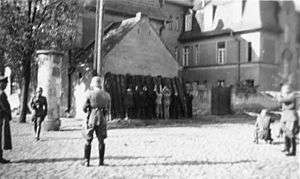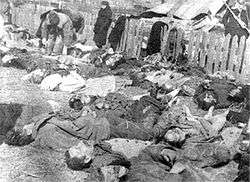Operation Tannenberg
| Operation Tannenberg Unternehmen Tannenberg | |
|---|---|
|
Operation Tannenberg, 20 October 1939, the mass murder of Polish townsmen in western Poland | |
| Location | German occupied Poland |
| Date | 1939 |
| Target | Polish people |
Attack type | Genocidal massacre, mass shooting |
| Weapons | Automatic weapons |
| Deaths | 20,000 deaths in 760 mass executions by SS Einsatzgruppen |
| Perpetrators |
|
Operation Tannenberg (German: Unternehmen Tannenberg) was a codename for one of the extermination actions by Nazi Germany that was directed at the Polish nationals during the opening stages of World War II in Europe, part of the Generalplan Ost for the German colonization of the East. The shootings were conducted with the use of a proscription list (Sonderfahndungsbuch Polen), compiled by the Gestapo in the span of two years before the 1939 attack.[1]
The top secret lists identified more than 61,000 members of the Polish elite: activists, intelligentsia, scholars, actors, former officers, and others, who were to be interned or shot. Members of the German minority living in Poland assisted in preparing the lists.[1] It is estimated that up to 20,000 Germans living in Poland belonged to organizations involved in various forms of subversion.[2]
Operation Tannenberg was closely followed by the Intelligenzaktion, a second phase of the Unternehmen Tannenberg directed by Heydrich's Sonderreferat from Berlin. It lasted until January 1940. In Pomerania alone, 36,000–42,000 Poles, including children, were killed before the end of 1939.[3]
Implementation

The plan was finalized in May 1939 by the Central Office II P (Poland). Following the orders of Adolf Hitler, a special unit dubbed Tannenberg was created within the Reich Main Security Office (Reichssicherheitshauptamt). It commanded a number of Einsatzgruppen der Sicherheitspolizei und des SD formed with Gestapo, Kripo and Sicherheitsdienst (SD) officers who were theoretically following the local Wehrmacht commanders. Their task was to track down and arrest all the people listed on the proscription lists exactly as it has been compiled before the outbreak of war.[4]
The first phase of the action occurred in August 1939 when about 2,000 activists of Polish minority organisations in Germany were arrested and murdered. The second phase of the action began on September 1, 1939, and ended in October, resulting in at least 20,000 deaths in 760 mass executions by Einsatzgruppen special task units with some help from regular Wehrmacht (armed forces). In addition, a special formation was created from the German minority living in Poland called Selbstschutz, whose members had trained in Germany before the war in diversion and guerilla fighting (see: Deutscher Volksverband, the German People's Union in Poland). The formation was responsible for many massacres and due to its bad reputation was dissolved by Nazi authorities after the September Campaign with transfer to regular formations.[5][6]
Mass killing of hospital patients

In the course of Operation Tannenberg patients from Polish hospitals were murdered in Wartheland (Wielkopolska) by Einsatzgruppe VI under Herbert Lange. He was appointed commandant of the first Chełmno extermination camp soon thereafter.[7] Already by mid-1940, Lange and his men were responsible for the murder of about 1,100 patients in Owińska, 2,750 patients at Kościan, 1,558 patients and 300 Poles at Działdowo who were shot in the back of the neck; and hundreds of Poles at Fort VII where the mobile gas-chamber (Einsatzwagen) was first developed along with the first gassing bunker.[8]
According to historian Peter Longerich, the hospital massacres were conducted on the sole initiative of Einsatzgruppen, because they weren't requested by Himmler to do so.[9] Lange's experience in the mass killing of Poles during Operation Tannenberg was the reason why Ernst Damzog, the Commander of Security Police and SD stationed in occupied Poznań (Posen) placed him in charge of the SS-Sonderkommando Lange (special detachment) for the purpose of mass gassing operations which led to the eventual annihilation of the Łódź Ghetto.[10]
See also
- Anti-Polonism
- Genocide
- Pacification operations in German-occupied Poland
- History of Poland (1939–1945)
- Wawelberg Group
- Operation Himmler
Notes and references
- 1 2 Unternehmen Tannenberg - August 1939: Wie der SD den Überfall auf Polen vorbereitete (III) bei wissen.spiegel.de (PDF file, direct download). (German)
- ↑ Tomasz Chinciński (November 4, 2009). "Prowokacje SD (Sicherheitsdienst)". Piąta kolumna (The 5th Column) (in Polish). S.P. Polityka. Retrieved August 13, 2012.
- ↑ Piotr Semków, IPN Gdańsk (September 2006). "Kolebka (Cradle)" (PDF). IPN Bulletin No. 8–9 (67–68), 152 pages. Warsaw: Institute of National Remembrance. 42–50 (44–51/152 in PDF). ISSN 1641-9561. Retrieved 8 November 2015 – via direct download: 3.44 MB.
- ↑ Peter Longerich (2012), War and Settlement in Poland. Heinrich Himmler: A Life. OUP Oxford, pp.425–429. ISBN 0199592322.
- ↑ Encyklopedia PWN, Intelligenzaktion. September–November 1939. (Polish)
- ↑ Piąta kolumna (Jungdeutsche Partei, Deutsche Vereinigung, Deutscher Volksbund, Deutscher Volksverbarid). Kampania Wrześniowa 1939.pl (2006). Retrieved 2 November 2015.
- ↑ Artur Hojan, Cameron Munro (2015). "Nazi Euthanasia Programme in Occupied Poland 1939-1945". Overview of the liquidation of the mentally ill during actions on the Polish territory (1939-1945). The Tiergartenstrasse 4 Association, international centre for the documentation, study and interpretation of Nazi crimes. Nazi Euthanasia in European Perspective conference, Berlin, Kleisthaus, Feb. 28-30, 2013. Retrieved 2 July 2015.
- ↑ Holocaust Research Project.org (2007). "Lange, Herbert; SS-Hauptsturmführer". Chelmno Death Camp Dramatis Personae. Holocaust Education & Archive Research Team. Retrieved 2013-05-13.
- ↑ Longerich 2012, p. 430.
- ↑ Epstein, Catherine (2010). "A Blonde Province: Resettlement, Deportation, Murder". Model Nazi: Arthur Greiser and the Occupation of Western Poland. Oxford University Press. p. 182. ISBN 0191613843. Retrieved 8 November 2015.
Bibliography
- Verbatim transcript of Part I of the book The German New Order in Poland published for the Polish Ministry of Information by Hutchinson & Co., London, in late 1941. The period covered by the book is September, 1939 to June, 1941.
- Jean Maridor, La Station de Radiodiffusion de Gleiwitz (Gliwice) - L'Opération TANNENBERG. (French)
- Several authors (2000). Monografia obozu KL Stutthof (KL Stutthof monograph) (Internet Archive) (in Polish). Contributing writers: Bogdan Chrzanowski, Konrad Ciechanowski, Danuta Drywa, Ewa Ferenc, Andrzej Gąsiorowski, Mirosław Gliński, Janina Grabowska, Elżbieta Grot, Marek Orski, and Krzysztof Steyer. Państwowe Muzeum Stutthof w Sztutowie.
Organization, Prisoners, Subcamps, Extermination, Responsibility.
- Andrzej Leszek Szcześniak (2001). Plan zagłady Słowian - Generalplan OST. Radom, POLWEN. ISBN 83-88822-03-9.
- Alfred Spiess, Heiner Lichtenstein: Unternehmen Tannenberg. Der Anlass zum Zweiten Weltkrieg. Korrigierte und erweiterte Ausgabe. (Ullstein-Buch ; Nr. 33118 : Zeitgeschichte) Ullstein, Frankfurt/M ; Berlin 1989, ISBN 3-548-33118-1.

